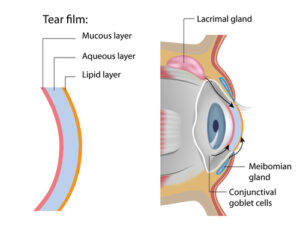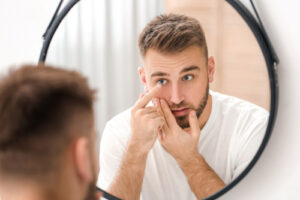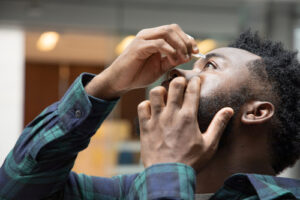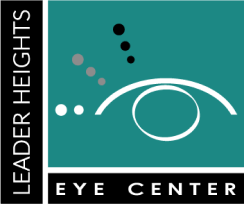Dry eye is a common condition that occurs when the eyes don’t produce enough tears or when the tears evaporate too quickly. At Leader Heights Eye Center, we understand the discomfort and frustration that can come with dry eye.
Our dry eye specialists have the knowledge and experience to help alleviate your symptoms by designing a treatment plan tailored to you!
Take the Dry Eye Self-TestRequest an Appointment
What is Dry Eye?

Dry eye is a common condition that occurs when your eyes do not produce enough tears or when the tears produced are not of sufficient quality to lubricate the eyes. Tears are important for maintaining the health of the eyes and for clear vision.
Your tears also help to protect the eyes from infection, wash away debris, and provide nutrients and oxygen to the surface of the eyes. Tears are made of three layers: a lipid layer, a water layer, and a mucin layer.
The structures that produce each layer must be properly functioning in order for you to have a healthy tear film. If one of these layers is lacking, it can cause the front surface of your eye to lack lubrication.
When your eyes lack lubrication, they will become dry, causing dry eye syndrome.
Free Dry Eye Self-Test
What Causes Dry Eye?
There are many factors that can contribute to dry eyes. Some of the most common causes include:
Aging
As you get older, your body naturally produces fewer tears, and the quality of your tears can also decline.
Environmental Factors

Exposure to wind, smoke, dry air, and air conditioning can all contribute to dry eye.
Medical Conditions
Certain medical conditions, such as rheumatoid arthritis, diabetes, and thyroid disorders, can contribute to dry eye.
Medications
Some medications, including antihistamines, decongestants, and antidepressants, can reduce tear production.
Hormonal Changes
Women may experience dry eyes during pregnancy, breastfeeding, and menopause due to changes in hormone levels.
Contact Lenses

Wearing contact lenses can aggravate dry eyes by reducing the amount of oxygen that reaches the surface of the eye.
These are only a few of the potential causes of dry eye. Determining the root cause of your symptoms will help your eye doctor create a treatment plan that will be more likely to be successful.
What Are the Most Common Symptoms of Dry Eye?
Dry eyes can cause a variety of bothersome symptoms. These symptoms can vary from person to person.
These are some of the most common symptoms of dry eye:

- Eye discomfort
- Redness
- Blurred vision
- Sensitivity to light
- Eye fatigue
- Excessive tearing
If you are experiencing any of these symptoms, see your eye doctor at Leader Heights Eye Center for an evaluation and proper diagnosis.
How Do Eye Doctors Diagnose Dry Eye?
Before examining your eyes, your eye doctor at Leader Heights Eye Center will ask you about your symptoms, including how long you have been experiencing them and if they typically occur after performing certain activities like working on the computer. We will spend the time listening and zero in on your exact problem.
Your eye doctor will then perform a comprehensive eye exam. This may include a test that measures your tear production, which measures the amount of tears produced by your eyes over a specified time period.
Testing Tear Quality
Your eye doctor may use a special paper strip or a small instrument to measure the tears. They also may test your tear quality.
A tear quality test evaluates the composition of the tears and checks for any abnormalities or deficiencies. Your eye doctor may also use a special dye to assess tear breakup time or examine the oil glands in the eyelids to check for blockages or inflammation.
Examining the Cornea
One of the most important parts of the evaluation will be a close examination of your cornea using a special microscope called a slit-lamp. This exam involves inspecting the cornea, conjunctiva, and other structures of the eye for any signs of damage, inflammation, or infection.
Once dry eye has been diagnosed, your eye doctor may recommend a variety of treatment options to help manage the condition and alleviate symptoms.
How is Dry Eye Treated at Leader Heights Eye Center?
At Leader Heights Eye Center, we offer a range of treatment options for dry eye, depending on the severity and underlying causes of the condition. In many cases, eye doctors recommend increasing the use of artificial tears.

Artificial tears are over-the-counter eye drops that can provide temporary relief of dry eye symptoms by lubricating and hydrating the eyes. In some cases, prescription eye drops may be necessary to treat more severe cases of dry eye.
These eye drops may contain medications to reduce inflammation, increase tear production, or improve tear quality. There are alternative treatment options for individuals with more severe cases of dry eye or for those whose condition does not improve with increased artificial tear use or medicated drops.
It is important that you closely follow your eye doctor’s treatment plan in order to improve your dry eye.
Can Dry Eye Lead to More Serious Issues If Left Untreated?
If you are experiencing symptoms of dry eye, it is very important to visit your eye doctor. In some cases, untreated dry eyes can lead to more serious issues.

Chronic dry eye can cause inflammation of the cornea and other structures of the eye, increasing the risk of eye infections and corneal ulcers. In severe cases, untreated dry eye can also lead to scarring of the cornea, which can cause vision problems.
It’s important to seek treatment for dry eyes to prevent these complications and improve your eye health and comfort. If you are experiencing symptoms of dry eye, you should consult with your eye doctor to determine the best course of treatment.
Are you experiencing symptoms of dry eye? Schedule an appointment at Leader Heights Eye Center in York, PA, today!
Request an Appointment Today!

